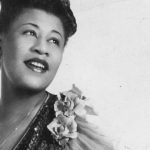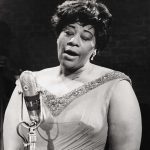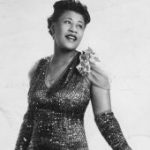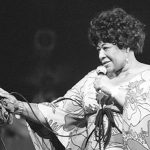Detroit Techno: Diversity and Raves
The Rave Scene Raves began in Detroit in the late 1980’s and primarily consisted of White Suburban youth. Techno: The New Dance Sound of Detroit caused a serious






Please click the red button above to be redirected to more photos of Ella Fitzgerald from Getty Images.
Ella Fitzgerald was a world renowned African American jazz singer beginning in the early 1940’s and lasted six decades. During her successful career she won numerous Grammy awards, guest starred on television shows, and worked with many of the musical greats of her generation. She originally began by seeking a dance career and accidently discovered her true musical gift of singing. Throughout her career there are times of struggle, triumph, and history making music recording. Her career was dynamic not only because of her singing but her ability to soar in a male dominated field. This research will discuss the pivotal moments of her career and how her ability to improvise and understand music led to her success .
Ella Fitzgerald became known as the mother of jazz because of her ability to imitate musical instruments while singing, diction, and rendition of lyrics.
Most successful singers have a troubled past and Ella Fitzgerald is no exception. Growing up in Yonkers, New York there were many negative influences within her environment. After her parents split at a young, she spent the remainder of her childhood living with her single mother. Coming from an impoverished background she had to find ways to survive and provide for her family. (Britannica Editors) Unfortunately, the only means of survival for many young African Americans during this time period was illegal. She spent time working as a lookout for a brothel and a messenger for a gambling ring. Her mother passed in 1934 and things only began to get worse after that. She lived with her aunt for a short time before dropping out of reform school and looking to the streets for opportunity. Despite her adversity she still knew that she wanted to be an entertainer. Fitzgerald entered a talent contest at the World Renowned Apollo Theatre, and ended up winning first prize for her singing ability. This was a pivotal moment in the life of Ella Fitzgerald because it is when she realized that she could have a career as a singer. Ella would then go on to be on the greatest jazz singers in a male dominated field.
Ella’s career as a jazz singer began in the mid 1930’s. During this time there were not many women in jazz, let alone women that looked like her. In order to be successful as a woman, the European aesthetic of beauty was the standard. The ideal look for a woman was long straight care, curvaceous, skinny, and fair skinned (Gavin 2007). During this era the “pressing” of African American hair became popular and widely accepted. Natural hair was unheard of and disapproved by all. Ella was none of the European standards of beauty and she was aware of it. Ella was often uncomfortable about having to perform live and it showed in her performances. In her early performances, her style of delivery was very timid, but she had a voice so unique and soothing that it worked. Being in a male dominated field and not fitting the standard beauty aesthetic was unheard of. In order to survive, Ella created a girl next door reputation so rather than lust for her, she was adored. Jazz musicians of the time period were associated with drug culture. (Gustafson 2017) Films would show scenes of young individuals listening to jazz and ragtime while doing drugs. Ella sealed this image with the recording of A-Tisket a Tasket, as the lead vocalist of Chick Webb’s orchestra (Gustafson 2017). The song was light and soothing with no mention of her personal affairs. Some critics suggest the song was not truly Jazz but pop music. Ella’s ability to exist as a jazz artist and an entertainer gave her the room to separate from the drug culture reputation. Her adoration was the key to gaining respect ,confidence, and kept her career to span over forty years. Ella’s beauty and drug culture was not the hill she had to climb, but racial tension and inequality was high during this time period.
African American singers between the 1930’s and 1960’s had a hard time finding places to perform and be respected. Many musicians were forced to take back entrances to hotels or halls and leave right after their performance. Although their music was accepted by the white audiences their color was not. Jim Crow Laws made performing and traveling especially difficult. Even after being given the permission to perform for white crowds, finding housing accommodations was almost impossible. The ability to perform and hold integrity for the African American, appeared to be bleak. Although Ella was not barred from such treatment, her manager Norman Ganz exposed and encouraged her to aspire to more. (Kuske 2017). Ganz was active in the Civil Rights Movement, primarily by making sure his artists were treated equally.
The Civil Rights Movement began in the mid 1950’s and continued on until 1968. The purpose of the movement was to fight for equality among African Americans and the white majority. The biggest goal of the movement was the elimination of Jim Crow Laws. These laws sanctioned the whereabouts of African Americans. Any placed labeled “colored” was deemed acceptable for African Americans and “white” was unacceptable. Entering could mean jail or even death depending on the severity of the situation, it meant jail for Fitzgerald. She held a concert in Houston in which there were no white and black sections. Although this was the doing of her manager, Ella and other musicians present were arrested for breaking the law. This was not discouraging but ignited a will for better. After this event, Ganz continued to find singing venues for Ella and despite segregation she was able to perform because of her popularity. In America’s capitalist society, the only thing that trumps racism occasionally is money. Managers had a greater want to make desire to make money than to follow Jim Crow Laws. Whether it was deliberate or not, Ella was paving the way for future generations and bridging the racial divide in this country.
Ella being so unique and adored gained fans of significance in American society. Marilyn Monroe was a popular sex symbol of the1950’s and more importantly a fan of Ella Fitzgerald. (Kuske 2017). She used her white privilege and influence to have Ella perform for engagements and led to Ella making history in Los Angeles. She became the first African American to perform at Mocambo nightclub, bringing her career to new heights. An interesting fact to note, was the need for white acceptance in order to succeed in a black field. Jazz originated in the black community in New Orleans in the late 19th century and although it didn’t fit the white aesthetic sound, it was accepted nonetheless. Ella succeeded many jazz musicians of the time period because of her unique timbre and pitch.
Many critics and journalist document Ella as having a unique ability to imitate instruments and a pitch unlike no other jazz artist of the time. While Ella was the queen of jazz she was the perfector of scatting. In Jazz, scat is known as the vocal improvisations of text with wordless vocals. The artist will keep the rhythm of the song while having their mouth make the sounds of different instruments. Throughout her performances Ella would break out in scat and the audience would swoon in admiration. Not only was she able to scat but people were often impressed by her ability to read sheet music and compose despite having no formal training. Her musical gift and understanding of the audience led to many of the musical hits singers still pay tribute to today.
Ella recorded thousands of tracks throughout her career but there about twenty songs that excelled in jazz and pop culture. You’ll Have to Swing It was written by Coslow and performed by Ella Fitzgerald in 1936. This was the beginning stages of her career and one of her first hits. The song says “If You Can Not Sing it, You Will Have to Swing It”. The song features her impeccable rang and scat improvisation abilities. As her career progressed she went on to sing over 200 albums and 2,000 songs but it was not without the occasional controversy. Although Webb had built a good girl image of herself, the recording of Wacky Dust was controversial but not surprising. The song alluded to jazz and cocaine and had Ella as the lead vocalist but soon after she completely removed herself was singing referenced to drugs. Her reputation was an important aspect to ensuring her success.
Ella Fitzgerald’s success elevated by her references as well. Throughout her Jazz career she has been compared to greats like Louis Armstrong. Armstrong was a male trumpeter and famous musician of the same time period. They recorded an album together under the leadership of Ganz in 1956. Although Ganz was the producer Armstrong had the final say as to who what would be put on the album. The album was released and became an automatic success, leading to future compilations between the two. Ella went on to work with many other great names and paving the way for women in music through her hard work and determination. Although she lived a life of adversity she did not let her circumstance define her destiny. Her success was because of the reason behind her music. She viewed her musical gift as a means to bring together community. Throughout history from the arrival of slaves to the United States to now, music has been used as a form of communication and togetherness. Ella Fitzgerald like many others, realized that her gift was her way to leave a mark on the world. Music is meant to create family bonds and understanding. It is when music loses its unison and community that things go awry.
Doane, Mary, “The Voice in the Cinema: The Articulation of Body and Space” Yale French Studies no. 60 (1980): 33-50; accessed September 30, 2017, http://www.jstor.org/stable/2930003?seq=1#page_scan_tab_contents
Holden, Stephen. June 16, 1996 “Ella Fitzgerald, the Voice of Jazz, Dies at 79
The New York Times. Retrieved 30 September 2017. http://www.nytimes.com/1996/06/16/nyregion/ella-fitzgerald-the-voice-of-jazz-dies-at-79.html?pagewanted=all
Gustafon, Adam, “Ella Fitzgerald’s flirtation with jazz’s historical drug culture”. 21 April 2017. Accessed 30 September 2017, http://www.independent.co.uk/arts-entertainment/music/ella-fitzgerald-drugs-jazz-reefer-marijuana-dope-culture-cocaine-wacky-dust-a7694331.html
Kuske, Rebecca, “Ella Fitzgerald: Breaking Down Racial Barrier with her voice”. Smithsonian 1 April 2017. Accessed 30 September 2017, http://americanhistory.si.edu/blog/ella-fitzgerald-voice
Nicholson, Stuart, Ella Fitzgerald: A Biography of the First Lady of Jazz . New York, NY: Routlcdge Publishing, 2003.
O’Dell, Cary. “Ella Fitzgerald Sings the Cole Porter Song Book”. National Registry. 2003
Rich, Frank. “Journal, How High the Moon” The New York Times. Retrieved 30 September 2017
The Biography.com Editors, “Ella Fitzgerald Biography.com” A&E Television Networks. Accessed 30 September 2017, https://www.biography.com/people/ella-fitzgerald-9296210
The Edhttp://americanhistory.si.edu/blog/ella-fitzgerald-voiceitors of Encyclopedia Britannica, “Ella Fitzgerald, American Singer”. Encyclopedia Britannica, Inc., 26 April 2017., Retrieved, 30 September 2017 https://www.britannica.com/biography/Ella-Fitzgerald
Telegraph Reports, “Ella Fitzgerald: One of the Greatest Singers of All Time”. The Telegraph. 24 February 2016. Accessed 30 September 2017



The Rave Scene Raves began in Detroit in the late 1980’s and primarily consisted of White Suburban youth. Techno: The New Dance Sound of Detroit caused a serious

Login to your account